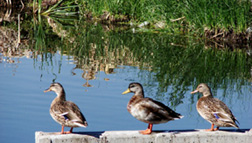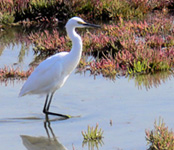|
Water Reclamation Plant Wetlands Project is 20 years old in October
Man made wetlands provides an abundance of diverse habitat and wildlife.
August 28, 2007
Twenty years ago this coming October the Water Reclamation Plant Wetlands Project was conceived. Organizations involved in its creation included Salt Lake City, Salt Lake County, Army Corp of Engineers, Division of Environmental Quality, Division of Wildlife Resources, Salt Lake City Mosquito Abatement, United States Fish and Wildlife Service, and the Audubon Society. Construction began in 1989 and was completed in 1990 at a cost of $200,000.
|
The project covers an approximate 40 acre plot of land and consists of about a mile and a 1-1/4 mile of free flowing channel, with water depths at some places in excess of 3 feet. The water surface area is roughly one third of the total plot, with average daily flow of around 3 million gallons of treated reclamation plant effluent traversing the site.
The site includes a dedicated discharge point regulated by a “UPDES permit” issued by the State of Utah Department of Environmental Quality. The water from the wetland is held to the same water quality standard as the reclamation plant effluent.
The abundance of bulrush, cattail, reed and other grass species provides habitat for many forms of life, ranging from the smallest meadow vole, and deer mouse, to muskrat, weasel, skunk, raccoon, and red fox. The wetlands animal diversity provides a balance between the various predators and other wildlife. The operation of the wetlands is such that nature prevails. The only exception is during the nesting period, when reclamation plant personnel are careful in the way they maintain the wetlands with equipment and flow changes. The operators’ maternal instincts do kick in during this nesting period,
|
The bird and waterfowl population varies greatly throughout the seasons. Many are just passing through in a migratory flight pattern, but others settle in to nest. Depending upon the time of year, there are Canada Geese families, many types of long-legged waders; such as the magnificent Great Blue Heron, or boisterous and comical American Avocet. Soaring above are various hawks, and the occasional Golden Eagle. Numerous species of blackbird cling to cattail and giant reeds, while many types of ducks and sandpiper-like birds stick close to the water. So far 89 species of birds, 11 species of mammals, 9 species of insects, 4 species of trees and shrubs and 38 species of vegetation have been identified at the site.
|
To accommodate the public, there is a large parking area outside of the facilities’ north fence line on 2300 North.
Photo Credits: Roger Lee




